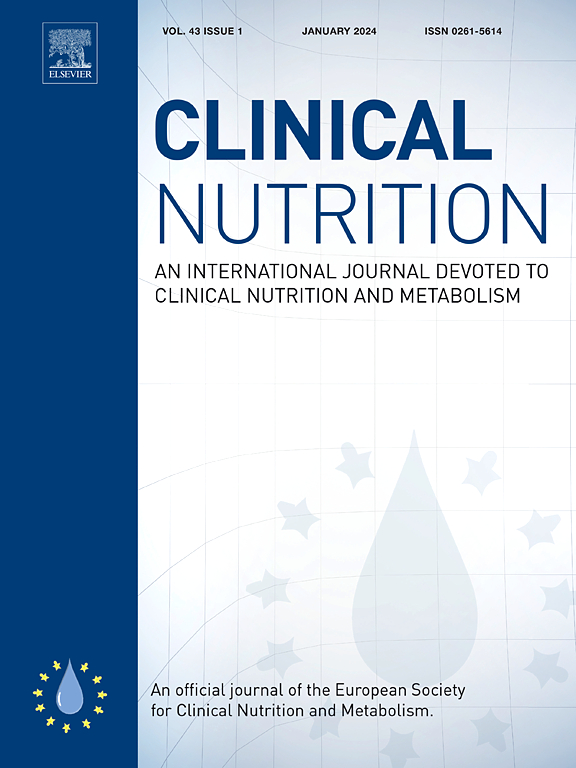一项全国性的横断面研究表明,成人住院患者中营养不良的流行程度及其对短期临床结果的预测重要性
IF 7.4
2区 医学
Q1 NUTRITION & DIETETICS
引用次数: 0
摘要
背景,目的营养不良是医院环境中的一个重要健康问题,具有持续的诊断挑战。尽管全球营养不良领导倡议(GLIM)标准提供了一种标准化的方法,但在全国范围内的验证和实施仍然有限。我们的目的是估计中国成人住院患者中由GLIM定义的营养不良的全国患病率,并评估GLIM标准对短期临床结果的预测价值。方法:我们于2023年2月至10月对中国31个省322个地点的成人住院患者进行了中国营养基础数据2022项目。营养不良是通过标准化的两步过程使用GLIM标准来定义的。临床结果包括出院结果、住院时间、住院费用和30天死亡率。我们使用逻辑分析和多元线性回归分析来检验营养不良严重程度与临床结果之间的关系。结果最终的分析包括61283人。24.6%的住院患者普遍存在营养不良(中度营养不良:13.8%;严重营养不良:10.8%)。营养不良严重程度与不良临床结局呈剂量-反应关系:中度和重度营养不良使出院无效结局的风险分别增加1.533倍(95% CI: 1.362-1.725)和2.200倍(95% CI: 1.958-2.473), 30天死亡率分别增加1.875倍(1.408-2.496)和3.065倍(2.332-4.028)。此外,中度和重度营养不良与住院时间分别增加0.97天和1.20天有关。结论中国成年住院患者营养不良普遍存在,且与不良临床预后密切相关。基于全球营养监测机制的评估和干预措施对于减轻营养不良负担至关重要。本文章由计算机程序翻译,如有差异,请以英文原文为准。
Prevalence and predictive importance for short-term clinical outcomes of GLIM-defined malnutrition among adult inpatients: A nationwide cross-sectional study
Background & aims
Malnutrition is a significant health issue in hospital settings, with persistent diagnostic challenges. Despite the Global Leadership Initiative on Malnutrition (GLIM) criteria providing a standardised approach, nationwide validation and implementation remain limited. We aimed to estimate the national prevalence of GLIM-defined malnutrition among Chinese adult inpatients and assess the predictive value of the GLIM criteria for short-term clinical outcomes.
Methods
We conducted the China Nutrition Fundamental Data 2022 project among adult inpatients from 322 sites across 31 provinces in China between February and October 2023. Malnutrition was defined using the GLIM criteria through a standardised two-step process. The clinical outcomes included discharge outcomes, length of stay, hospitalisation costs, and 30-day mortality. We used logistic and multiple linear regression analyses to examine the association between malnutrition severity and clinical outcomes.
Results
The final analysis included 61,283 individuals. Malnutrition was prevalent in 24.6 % of the inpatients (moderate malnutrition: 13.8 %; severe malnutrition: 10.8 %). A dose–response relationship was observed between malnutrition severity and adverse clinical outcomes: moderate and severe malnutrition increased the risk of ineffective discharge outcomes by 1.533 (95 % CI: 1.362–1.725) and 2.200 (1.958–2.473) times, respectively, and 30-day mortality by 1.875 times (1.408–2.496) and 3.065 (2.332–4.028) times, respectively. Additionally, moderate and severe malnutrition were linked to a 0.97-day and 1.20-day increases in hospital stays, respectively.
Conclusions
Malnutrition is prevalent among adult Chinese inpatients and strongly associated with adverse clinical outcomes. GLIM-based assessments and interventions are essential to reduce the burden of malnutrition.
求助全文
通过发布文献求助,成功后即可免费获取论文全文。
去求助
来源期刊

Clinical nutrition
医学-营养学
CiteScore
14.10
自引率
6.30%
发文量
356
审稿时长
28 days
期刊介绍:
Clinical Nutrition, the official journal of ESPEN, The European Society for Clinical Nutrition and Metabolism, is an international journal providing essential scientific information on nutritional and metabolic care and the relationship between nutrition and disease both in the setting of basic science and clinical practice. Published bi-monthly, each issue combines original articles and reviews providing an invaluable reference for any specialist concerned with these fields.
 求助内容:
求助内容: 应助结果提醒方式:
应助结果提醒方式:


